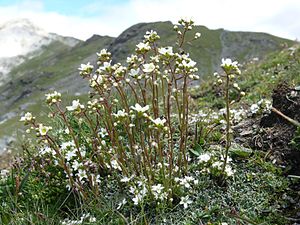Panicle saxifrage
| Panicle saxifrage | ||||||||||||
|---|---|---|---|---|---|---|---|---|---|---|---|---|

Grape Saxifrage ( Saxifraga paniculata ) in the Zillertal Alps |
||||||||||||
| Systematics | ||||||||||||
|
||||||||||||
| Scientific name | ||||||||||||
| Saxifraga paniculata | ||||||||||||
| Mill. |
The Saxifraga paniculata ( Saxifraga paniculata Mill. , Syn .: Saxifraga aizoon Jacq. , Chondrosea aizoon ( Jacq. ) Haw. ), And grape-stone crushing or Evergreen saxifrage , belonging to the genus saxifrage ( Saxifraga ).
description
The plant becomes about 5 to 30 cm high. The evergreen, fleshy leaves form one to six centimeters wide hemispherical rosette pads. As with the blue-green saxifrage ( S. caesia ), the leaves actively secrete lime at the edge and are often covered with a light gray layer of lime. The basal sheets are 3–6 mm long and ovate, with short ciliates. The white to yellowish, often red-dotted flowers are around 8 to 15 mm in size. They stand in loose, panicle-like clusters on the mostly glandular hairy stems. The panicle branches are one to three-flowered.
The flowering period is May to August, depending on the altitude.
The species has chromosome number 2n = 28.
Occurrence
The lime-loving plant prefers rocky alpine lawns, crevices and rock corridors up to the alpine altitude (about 3400 m ). Sociologically, it is a characteristic of the Potentilletalia caulescentis. According to observations in the Swabian Alb , the grape saxifrage occurs in the Drabo-Hieracietum humilis, in the Diantho-Festucetum pallescentis and in the Valeriano-Seslerietum. The distribution area in Europe includes the mountains from the Pyrenees, the Alps , the Apennines, the Carpathians to the mountains of the Balkan Peninsula. But it also occurs in Iceland and Norway and populates (mostly in special subspecies or varieties) the mountains in Eurasia and North America.
ecology
The plant is very drought-resistant and frost-hardy and therefore well adapted to extreme site conditions. The angles of the leaf teeth have water crevices ( hydathodes ) that actively separate calcium-rich water in order to reduce the excess of calcium. After the water has evaporated , small limescale remains there. Evergreen, small leaves use every ray of sunshine, the water supply is protected in the fleshy leaves with a thick epidermis, arrangement in rosettes, innate frost resistance. Assimilation is possible even in winter in snow-free places .
According to observations in the Swabian Alb , the species is light-loving, tolerates partial shade, but rather avoids exposure to full sun from the south. It thrives on lime-rich rocks, especially on rock heads and ledges, also on consolidated rock debris. However, it does not take root with the main root in crevices, but with many finer roots in the thin humus layer above the rocks, often together with carpet-forming mosses.
The flowers are "nectar-bearing disc flowers"; they are distinctly male; the stylus develop until after dusting the dust bag . The two-leaf ovary ends in 2 free styles. The yellow spots at the base of the petals increase the signaling effect of the stamens and replace them after the anthers have been thrown off (anthers imitation). This is to prevent the pollinators from avoiding the flowers outside the male phase. Over 90 species of insects, mostly flies , are possible pollinators. The flowering period is May to August, depending on the altitude.
The fruits are columnar capsules. The very small seeds are spread out as granule fliers. Fruit ripens from September. Vegetative reproduction occurs through runners up to 4 cm long.
literature
- Xaver Finkenzeller: Alpine flowers , ISBN 3-576-11482-3
- Wolfgang Adler, Karl Oswald, Raimund Fischer: Excursion flora of Austria. Ed .: Manfred A. Fischer . Ulmer, Stuttgart / Vienna 1994, ISBN 3-8001-3461-6 .
- Ruprecht Düll , Herfried Kutzelnigg : Pocket dictionary of plants in Germany and neighboring countries. The most common Central European species in portrait. 7th, corrected and enlarged edition. Quelle & Meyer, Wiebelsheim 2011, ISBN 978-3-494-01424-1 .
- Klaus Kaplan in Gustav Hegi : Illustrated flora of Central Europe . Volume IV, Part 2 A, 3rd edition, pages 162-165. Blackwell Wissenschaftsverlag Berlin 1995. ISBN 3-8263-3016-1
Individual evidence
- ^ Erich Oberdorfer : Plant-sociological excursion flora for Germany and neighboring areas . 8th edition, page 489. Stuttgart, Verlag Eugen Ulmer, 2001. ISBN 3-8001-3131-5
- ^ A b Oskar Sebald: Saxifragaceae . In: O. Sebald u. a .: The fern and flowering plants of Baden-Württemberg . Volume 3, pages 270-272. Verlag Eugen Ulmer, Stuttgart 1992. ISBN 3-8001-3314-8
- ↑ Jaakko Jalas, Juha Suominen, Raino Lampinen, Arto Kurtto: Atlas florae europaeae . Volume 12 (Resedaceae to Platanaceae). Pages 165–166, Helsinki 1999. ISBN 951-9108-12-2
Web links
- Panicle saxifrage. In: FloraWeb.de.
- Panicle saxifrage . In: BiolFlor, the database of biological-ecological characteristics of the flora of Germany.
- Profile and distribution map for Bavaria . In: Botanical Information Hub of Bavaria .
- Saxifraga paniculata Mill. In: Info Flora , the national data and information center for Swiss flora . Retrieved November 1, 2015.
- Thomas Meyer: Data sheet with identification key and photos at Flora-de: Flora von Deutschland (old name of the website: Flowers in Swabia )

